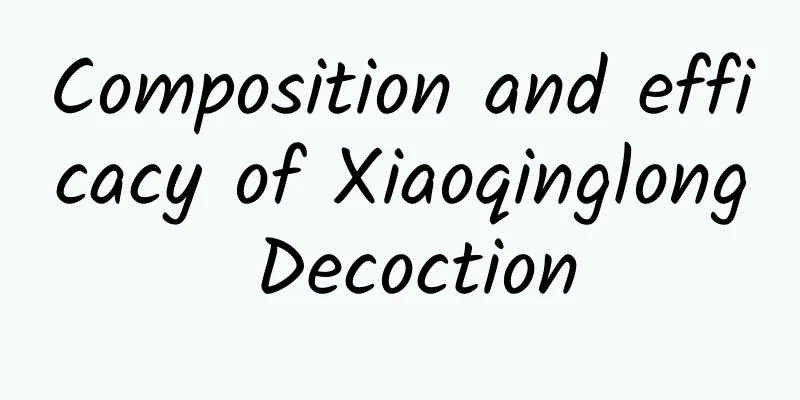Composition and efficacy of Xiaoqinglong Decoction

|
Xiaoqinglong Decoction has the effects of tonifying deficiency, dispelling cold, warming the lungs and transforming phlegm. Ephedra and cinnamon twig are the main ingredients in Ju Rui, which can induce sweating, replenish deficiency, dispel cold and open up the lungs; Paojiang and Asarum are the auxiliary ingredients, which can warm the lungs and transform fluid, and help ephedra and cinnamon twig to replenish deficiency; Schisandra chinensis can restrain qi, Paeonia lactiflora can invigorate qi and nourish blood, Pinellia ternata can transform phlegm, harmonize the stomach and eliminate stagnation, and also serve as adjuvants; Roasted Licorice can nourish blood and strengthen the body, and also has the function of an adjuvant. Xiaoqinglong Decoction is the name of a Chinese medicine prescription. It is a tonic that has the effects of relieving exterior symptoms with pungent and warm properties, replenishing deficiency and dispelling cold, and warming the lungs and transforming phlegm. It is mainly used to treat external cold and internal fluid syndrome. Fever and chills, headache and body pain, no sweating, wheezing and coughing, clear and thin sputum in large amounts, chest tightness, or nausea, or wheezing and coughing due to phlegm and fluid, inability to lie flat, or heavy pain in the body, edema of the face and limbs, white and slippery tongue coating, and floating pulse. It is used in clinical medicine to treat chronic obstructive pulmonary emphysema, bronchial asthma, acute bronchitis, pneumonia, whooping cough, allergic rhinitis, catarrhal ophthalmia, catarrhal otitis media, etc., which are symptoms of external cold and internal fluid retention. This syndrome is caused by cold symptoms binding the exterior, the suppression of Wei Yang, and the stimulation of internal fluid by the exterior cold. The main treatment is to nourish the deficiency, dispel the cold, warm the lungs and eliminate the phlegm. Water and cold collide with each other, and the inside and outside are attracted to each other, causing the fluid to move around. The water and cold attack the lungs, causing the lungs to fail to descend, resulting in coughing with a lot of thin sputum; water stagnates under the heart, blocking the circulation of qi, causing chest fullness; when the fluid moves, the stomach qi goes against the flow, causing nausea; the water and fluid overflow onto the skin, causing edema and heaviness of the body; the bitter, white and slippery tongue and the floating pulse are evidence of external cold and internal fluid. For other symptoms of cold and internal fluid retention other than these, if one does not relieve the exterior symptoms but only treats the fluid, the exterior evil will be difficult to defeat; if one does not transform the fluid but only disperses the exterior evil, the water fluid will be difficult to eliminate. Therefore, the treatment should coordinate tonifying deficiency and transforming phlegm, so as to relieve both the internal and external symptoms in one go. Ephedra and cinnamon twig are the main ingredients, which can induce sweating and dispel cold to replenish deficiency evil. Ephedra can also promote lung qi deficiency and stop wheezing and coughing, while cinnamon twig can transform qi and promote water circulation to facilitate the transformation of internal drinking. Paojiang and asarum are the assistant ingredients, which warm the lungs and transform phlegm, while also assisting hemp and cinnamon in replenishing deficiency and expelling evil. As everyone knows, there is phlegm and turbidity, and the spleen and lungs are weak. If only pungent and warm medicines are used to disperse it, it may damage the body's energy. Therefore, Schisandra chinensis is used to astringe the lungs, relieve cough and resolve phlegm, and Paeonia lactiflora is used to nourish the blood; Pinellia ternata is used to eliminate dampness, relieve cough and resolve phlegm, harmonize the stomach and reduce adverse reactions, and is also an adjuvant. Roasted licorice root is also an adjuvant medicine, which can nourish blood and strengthen the body, and also regulate the pungent, dispersing, sour and astringent properties. |
<<: Xiao Jianzhong Decoction Harm
>>: Xiaoqinglong Decoction for the Treatment of Asthma
Recommend
What causes peeling toes?
Toe peeling is a very common skin disease that oc...
Dosage of the original formula of Ma Xing Shi Gan Tang
The dosage of the original formula of Ma Xing Shi...
How to treat abnormal kidney function
Abnormal renal function has a great impact on hea...
What medicine is effective for stomach cramps?
The stomach is the most important organ in our hu...
Acute renal failure
There are many common types of diseases. When tre...
Treatment of cervical spondylotic radiculopathy: targeted treatment is the most important
If radiculopathy is not serious, surgery is not r...
Why does it hurt when I press my breasts?
For women, if there is tenderness on both sides o...
He-Ne laser treatment for acne
Helium-neon laser is also a relatively common las...
It's amazing that you can find hidden diseases by sticking to it for 30 seconds
Hands are not only used to hold things and do thi...
Men need to stay fresh, how can you know if you don't try these methods
Men are very tired. They have to make women happy...
Myrtle wine effects and functions
The main ingredient of myrtle wine is myrtle, whi...
Black wolfberry price
Black wolfberry is also called wild black wolfber...
The efficacy and function of wormwood cushion
We all know about moxibustion as a way of prevent...
Liver failure
The liver is a large organ in the human body. The...
What causes headaches before and after menstruation?
Women will experience some abnormal changes in th...









